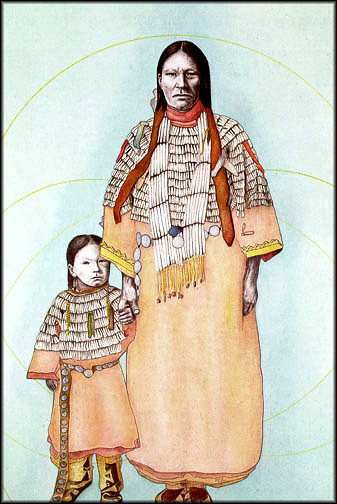A study of Mrs. Left Hand and child, Dakota (Sioux), and the spiritual bonds that exist between them (from a circa 1900 photograph). Both are adorned with dentalium shells and wear long belts decorated with silver conches.
The Indians of the Plains were a nomadic people whose life revolved around the buffalo and its migrations. The men were fully taken up with hunting, fighting to retain their hunting territories, their horses, and with ceremonies that gave strength to these endeavors. Most of the manufactures of the tribe were the responsibility of the women. Skins and other natural products were both their equipment and the material for her art. Her position was respected and her crafts were highly valued.
Among the Haudenosaunee (Iroquois) of the Eastern woodlands, the principal mothers of the clans appointed the sachems to a representational senate to deliberate on national policy. These men, the principal civil guides of the nation, were carefully observed in childhood and were selected and tutored by women for their character and leadership qualities.
Their responsibility did not end with the selection of the chief; they also sat in on the deliberations and held the sachems accountable for their conduct. If one proved to be self-serving, the Clan mothers could have him removed.
The creativity of this type of woman produced the high degree of art so evident in Indian culture. A man’s offer to help with her difficult tasks would usually be scorned. He had his place and she had hers. The bond between Indian women and the land is as old as the Creation Story, in which a woman was the original caretaker. From this beginning sprang forth Indian women’s special yet natural relationship to the land, since it is they who continue to labor, give birth, nurture and care for life.
